1993 CADILLAC FLEETWOOD tow
[x] Cancel search: towPage 45 of 386
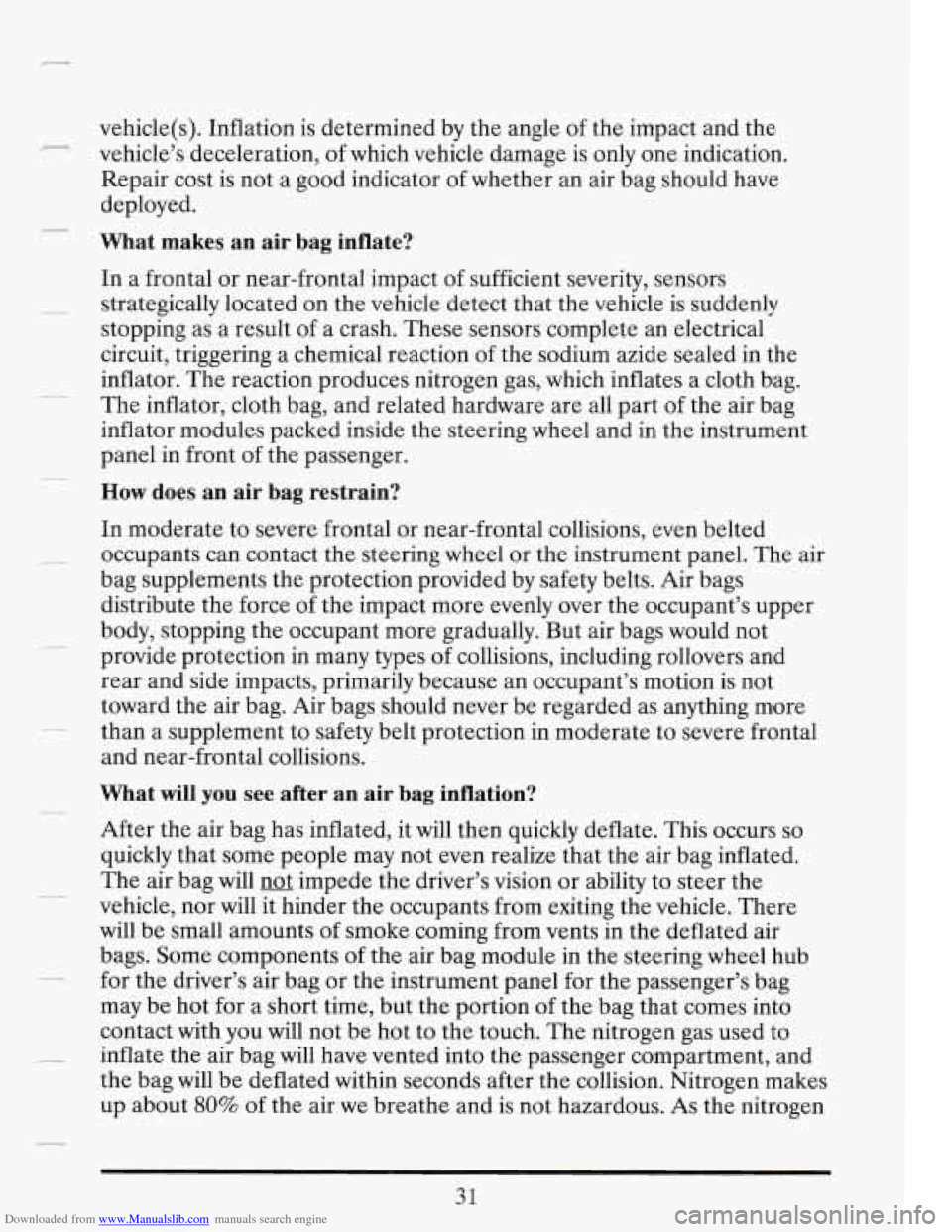
Downloaded from www.Manualslib.com manuals search engine vehicle@). Inflation is determined by the angle of the impact and the
vehicle’s deceleration, of which vehicle damage is only one indication.
Repair cost is not a good indicator of whether an air bag should have
deployed. 2-
_I What makes an air bag inflate?
In a frontal or near-frontal impact of sufficient severity, sensors
- strategically located on the vehicle detect that the vehicle is suddenly
stopping as a result of a crash. These sensors complete an electrical
circuit, triggering a chemical reaction of the sodium azide sealed in the
inflator. The reaction produces nitrogen gas, which inflates a cloth bag.
The inflator, cloth bag, and related hardware are all part of the air bag
inflator modules packed inside the steering wheel and in the instrument
panel in front
of the passenger.
How does an air bag restrain?
In moderate to severe frontal or near-frontal collisions, even belted
occupants can contact the steering wheel or the instrument panel. The air
bag supplements the protection provided by safety belts. Air bags
distribute the force of the impact more evenly over the occupant’s upper
body, stopping the occupant more gradually. But air bags would not
provide protection in many types of collisions, including rollovers and
rear and side impacts, primarily because an occupant’s motion is not
toward the air bag. Air bags should never be regarded as anything more
and near-frontal collisions.
What will you see after an air bag inflation?
__ than a supplement to safety belt protection in moderate to severe frontal
After the air bag has inflated, it will then quickly deflate. This occurs
so
quickly that some people may not even realize that the air bag inflated.
The air bag will
not impede the driver’s vision or ability to steer the
vehicle, nor will it hinder the occupants from exiting the vehicle. There
will be small amounts of smoke coming from vents in the deflated air
bags. Some components of the air bag module in the steering wheel hub
may be hot for a short time, but the portion of the bag that comes into
contact with you will not be hot to the touch. The nitrogen gas used to
inflate the ‘air bag will have vented into the passenger compartment, and
the bag will be deflated within seconds after the collision. Nitrogen makes
up about
80% of the air we breathe and is not hazardous. As the nitrogen
-
-- for the driver’s air bag or the instrument panel for the passenger’s bag
31
Page 73 of 386
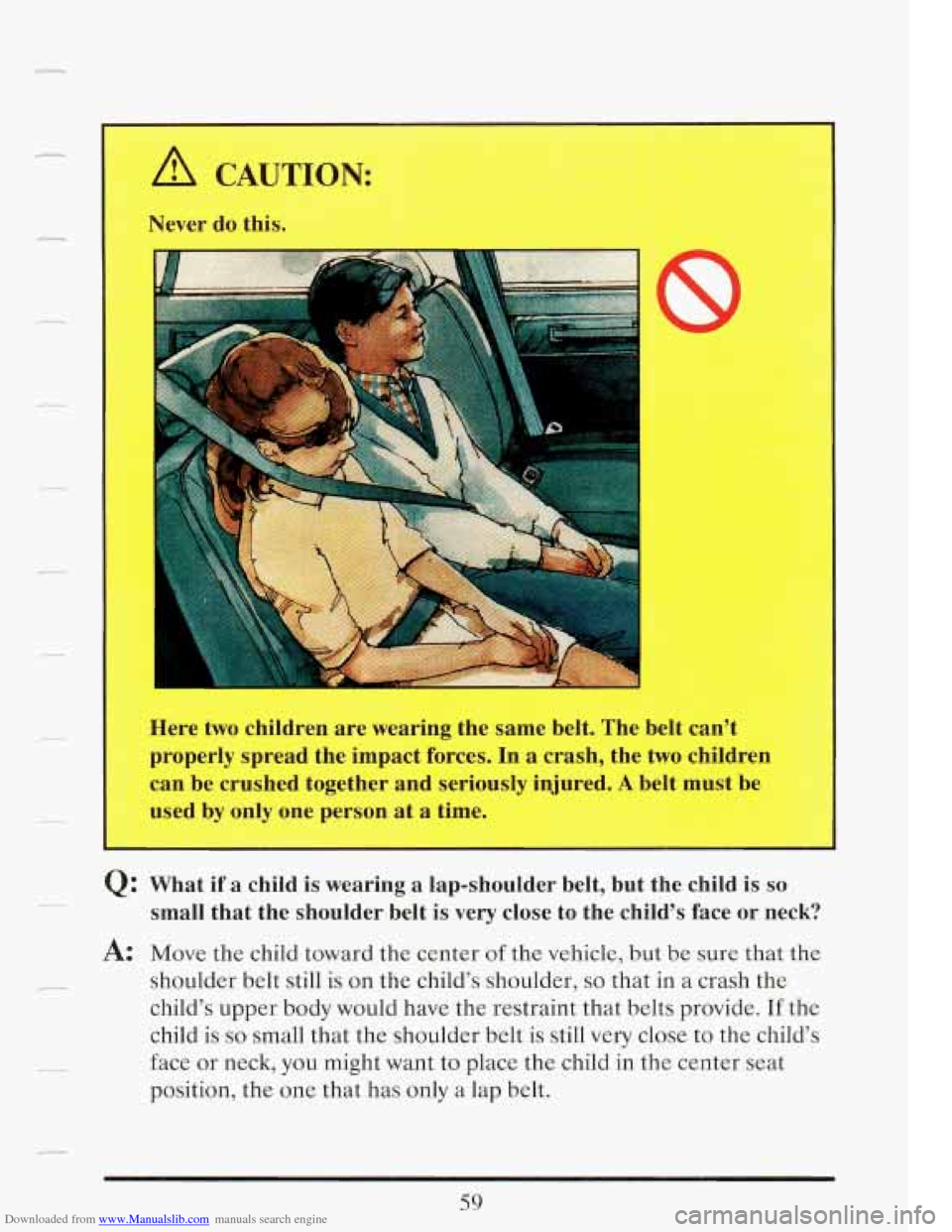
Downloaded from www.Manualslib.com manuals search engine A CAUTION:
Never do this.
I
Here two children are wearing the same belt. The belt can’t
properly spread the impact forces. In a crash, the
two children
can be crushed together and seriously injured.
A belt must be
used by only one person at
a time.
Q: What if a child is wearing a lap-shoulder belt, but the child is so
small that the shoulder belt is very close to the child’s face or neck?
A: Move the child toward the center of the vehicle, but be sure that the
shoulder belt still is on the child’s shoulder,
so that in a crash the
child’s upper body would have the restraint that belts provide.
If the
child is so small that the shoulder belt is still very close to the child’s
face
or neck, you might want to place the child in the center seat
position, the one that has only a lap belt.
59
Page 93 of 386
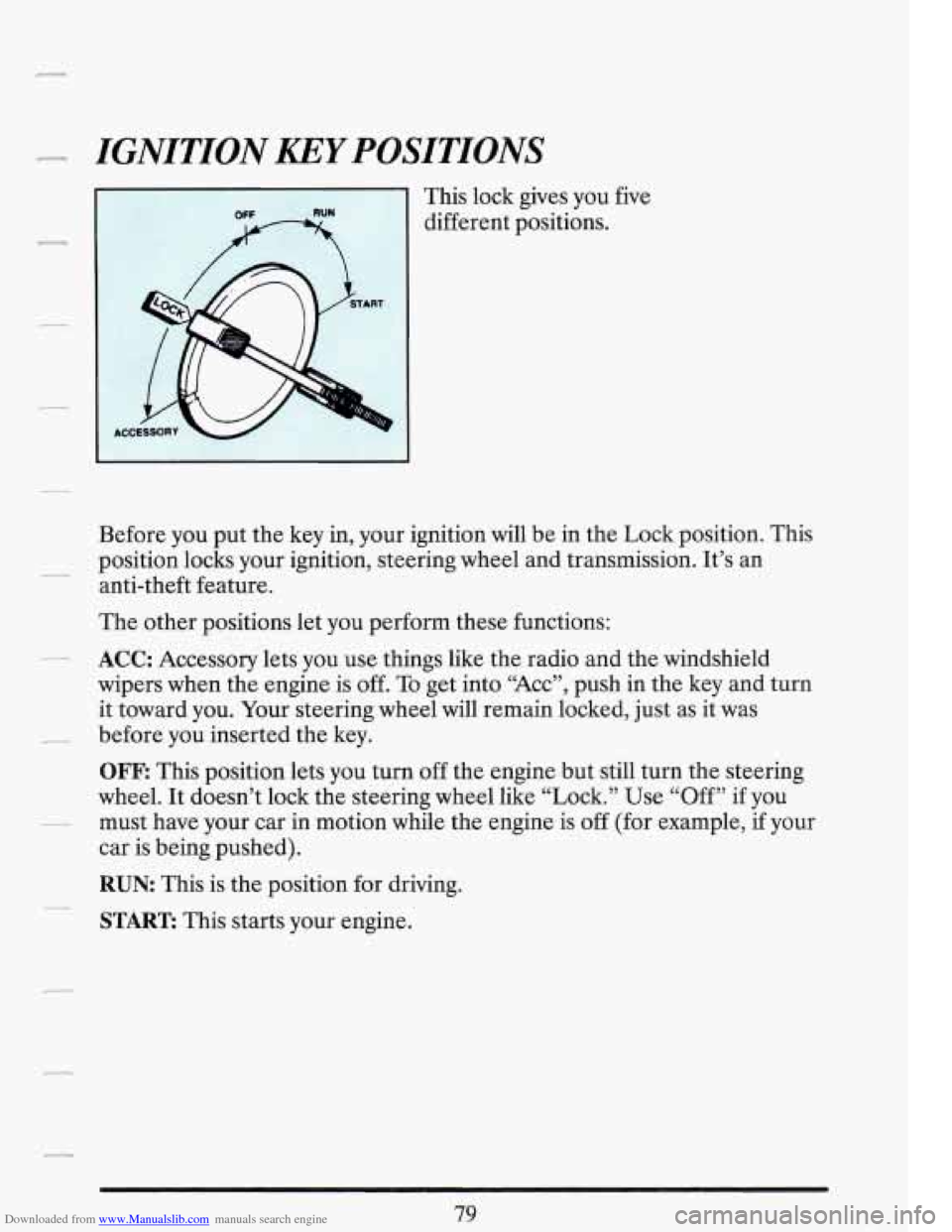
Downloaded from www.Manualslib.com manuals search engine IGNITION KEY POSITIONS
This lock gives you
different positions. five
Before you put the key in, your ignition will be in the Lock position. This
anti-theft feature.
- position locks your ignition, steering wheel and transmission. It’s an
The other positions let you perform these functions:
wipers when the engine is off.
To get into “Acc”, push in the key and turn
it toward you. Your steering wheel will remain locked, just as it was
before you inserted the key.
OFF: This position lets you turn off the engine but still turn the steering
wheel. It doesn’t lock the steering wheel like “Lock.” Use “Off”
if you
car is being pushed).
RUN This is the position for driving.
STARE This starts your engine.
- ACC: Accessory lets you use things like the radio and the windshield
- must have your car in motion while the engine is off (for example, if your
-
79
Page 98 of 386
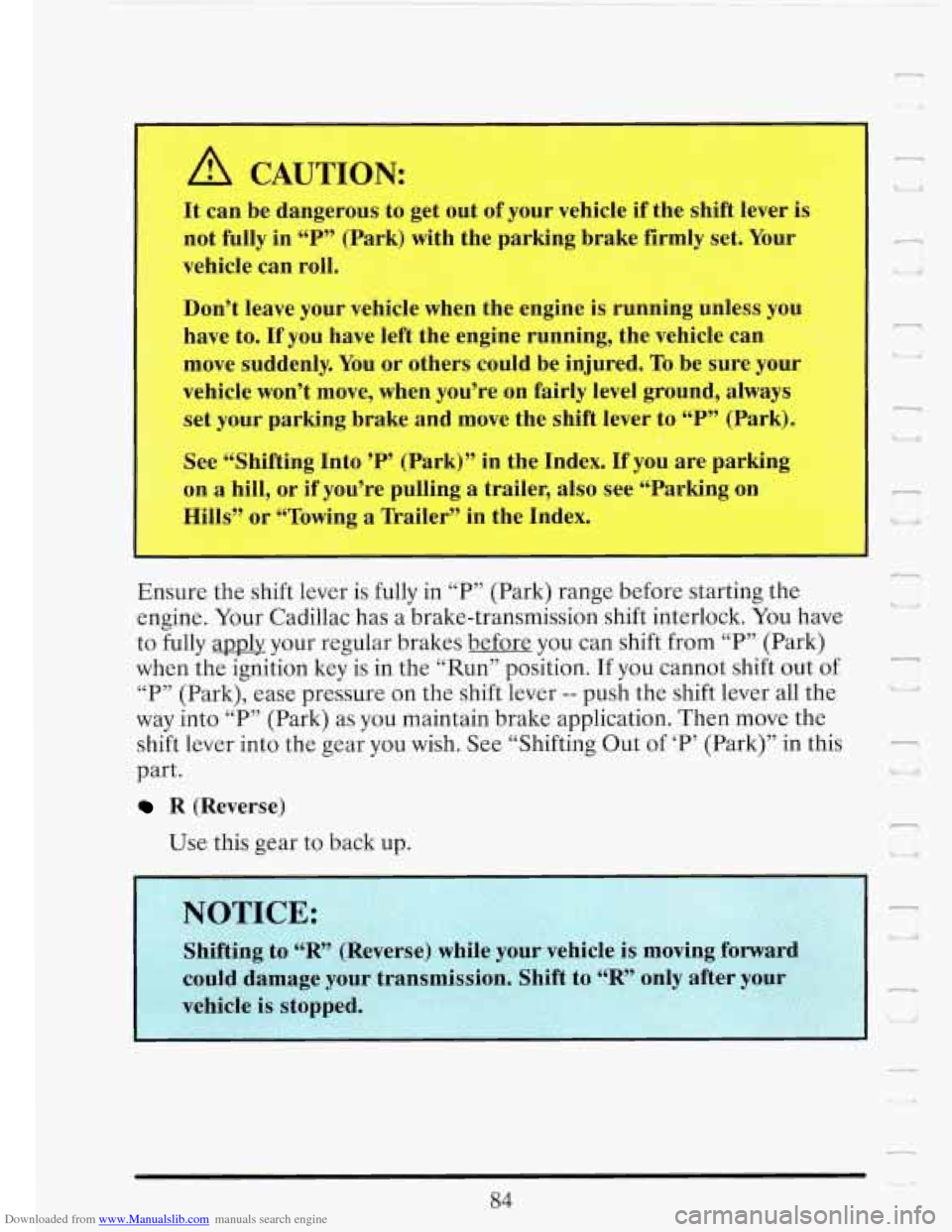
Downloaded from www.Manualslib.com manuals search engine A CAUTION:
It can be dangerous to get out of your vehicle if the shift lever is
not fully
in “P” (Park) with the parking brake firmly set. Your
vehicle can roll.
Don’t leave your vehicle when the engine is running unless
you
have to. If you have left the engine running, the vehicle can
move suddenly. You or others could be injured.
To be sure your
vehicle won’t move, when you’re on fairly level ground,
always
set your parking brake and move the shift lever to “P” (Park).
See “Shifting Into ’P’ (Park)” in the Index. If you are parking
on
a hill, or if you’re pulling a trailer, also see “Parking on
Hills’’ or “Towing a Railer” in the Index.
Ensure the shift lever is fully in “P” (Park) range before starting the
engine. Your Cadillac has a brake-transmission shift interlock. You have
to fully apply your regular brakes before you can shift
from “P” (Park)
when the ignition key
is in the “Run” position. If you cannot shift out of
“P” (Park), ease pressure on the shift lever
-- push the shift lever all the
way into “P” (Park) as you maintain brake application. Then move the
shift lever into the gear you wish. See “Shifting Out of
‘P’ (Park)” in this
part.
R (Reverse)
Use this gear to back up.
I
ha
1 UI
r
.i
I 4
84
‘- I
Page 99 of 386
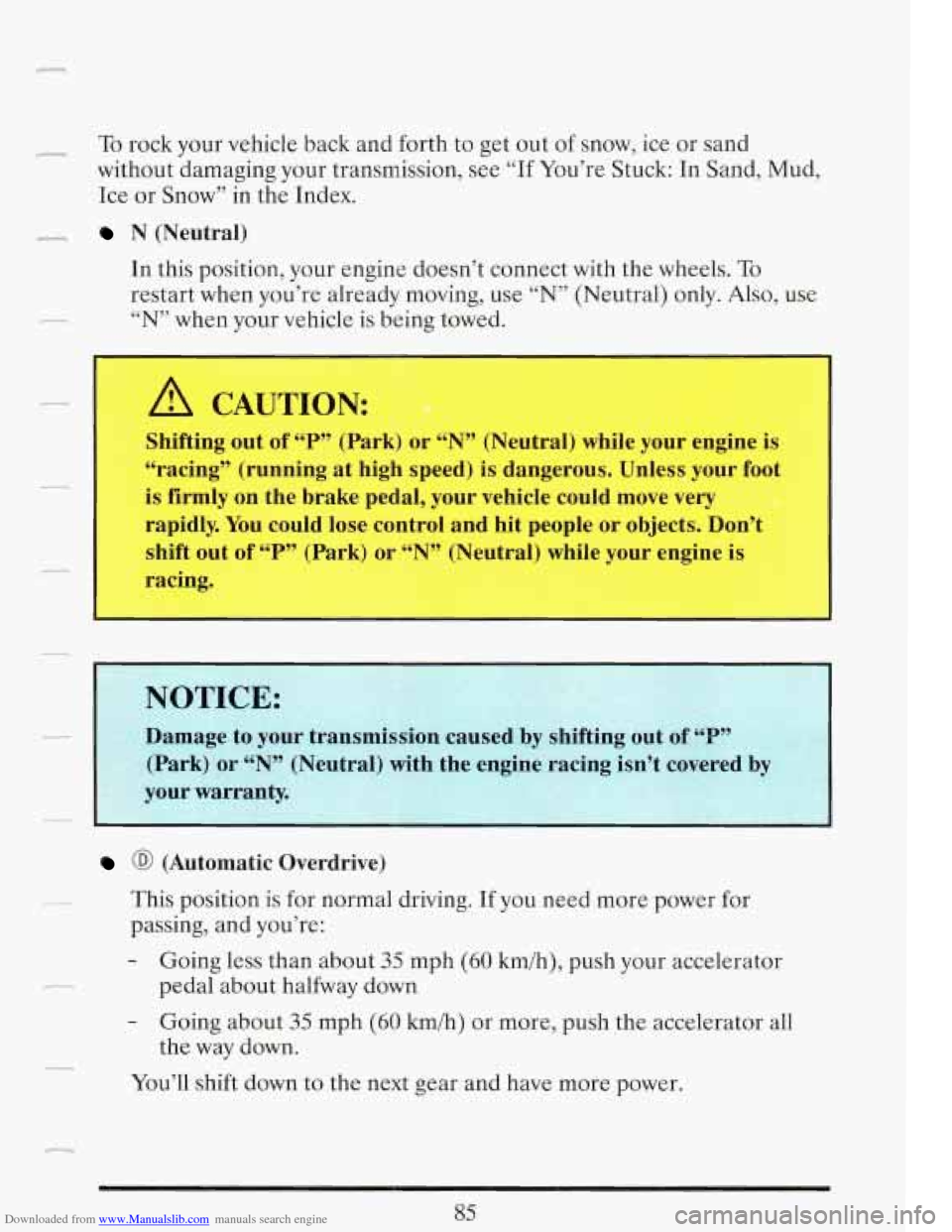
Downloaded from www.Manualslib.com manuals search engine r To rock your vehicle back and forth to get out of snow, ice or sand
without damaging your transmission, see
“If You’re Stuck: In Sand, Mud,
Ice
or Snow” in the Index.
N (Neutral)
In this position, your engine doesn’t connect with the wheels.
To
restart when you’re already moving, use “N” (Neutral) only. Also, use
“N” when your vehicle is being towed.
A CAUTION:
Shifting out of “P” (Park) or “N” (Neutral) while your engine is
“racing” (running at high speed) is dangerous. Unless your foot
is firmly on the brake pedal, your vehicle could move very
rapidly. You could lose control and hit people or objects. Don’t
shift out of
“P” (Park) or “N” (Neutral) while your engine is
racing.
c
c-
r
@ (Automatic Overdrive)
This position is for normal driving.
If you need more power for
passing, and you’re:
- Going less than about 35 mph (60 kmih), push your accelerator
- Going about 35 mph (60 km/h) or more, push the accelerator all
You’ll shift down to the next gear and have more power.
pedal about
halfway down
the way down.
85
Page 100 of 386
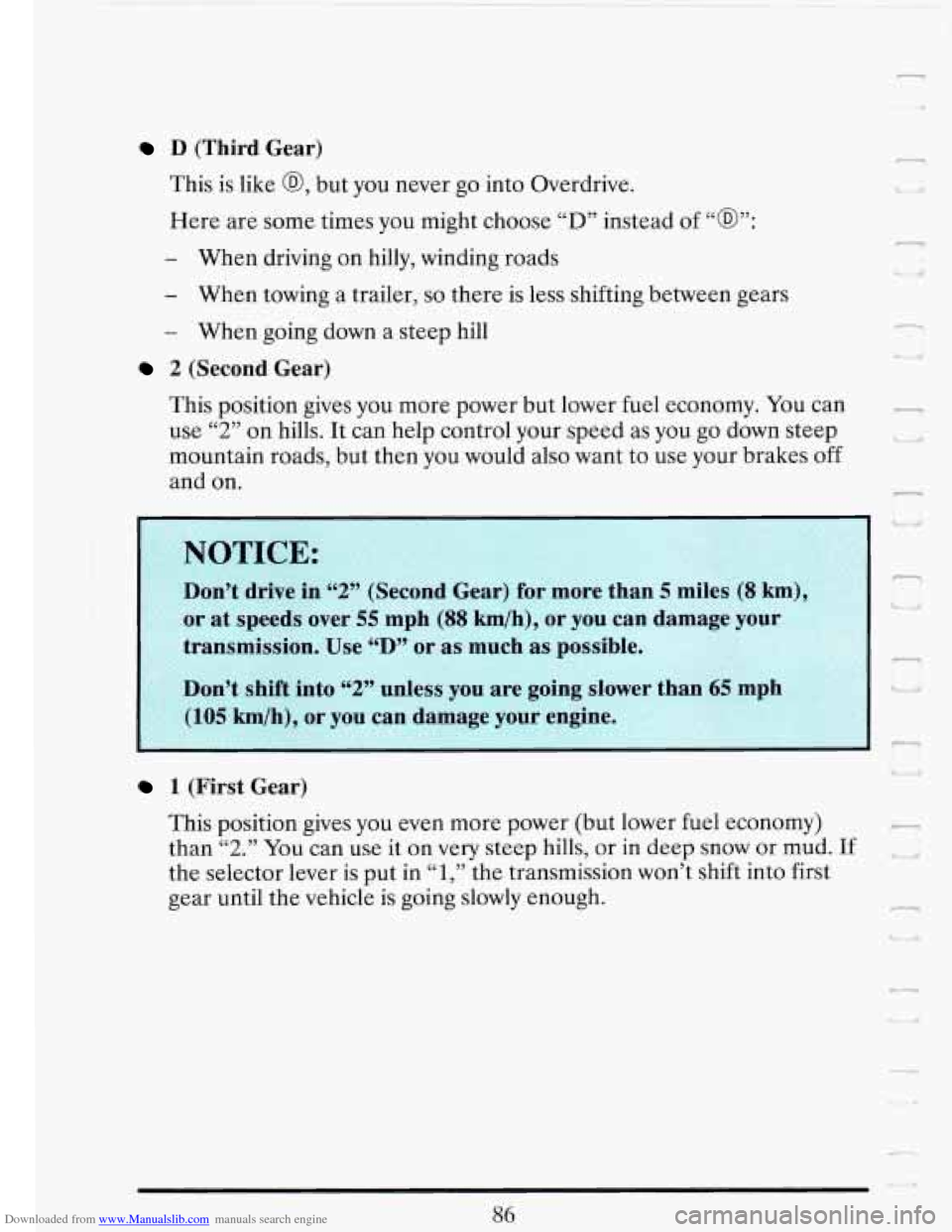
Downloaded from www.Manualslib.com manuals search engine D (Third Gear)
This is like
@, but you never go into Overdrive.
Here are some times you might choose
“D” instead of “a”:
- When driving on hilly, winding roads
- When towing a trailer, so there is less shifting between gears
- When going down a steep hill
2 (Second Gear)
P
bl ia
This position gives you more power but lower fuel economy. You can -
use 2 on hills. It can help control your speed as you go down steep
mountain roads, but then you would also want to use your brakes
off
and on.
cc 97 ,>
NOTICE:
Don’t drive in “2” (Second Gear) for more than 5 miles (8 km),
or at speeds over 55 mph (88 km/h), or you can damage your
transmission. Use “D” or as much
as possible.
Don’t shift into
“2” u are going slower than 65 mph
(105 km/h), or you can damage your engine.
1 (First Gear)
I-
This position gives you even more power (but lower fuel economy) r
than “2.” You can use it on very steep hills, or in deep snow or mud. If I
the selector lever is put in “1,” the transmission won’t shift into first
gear until the vehicle is going slowly enough.
- I,
U
-.
L.
86
Page 103 of 386
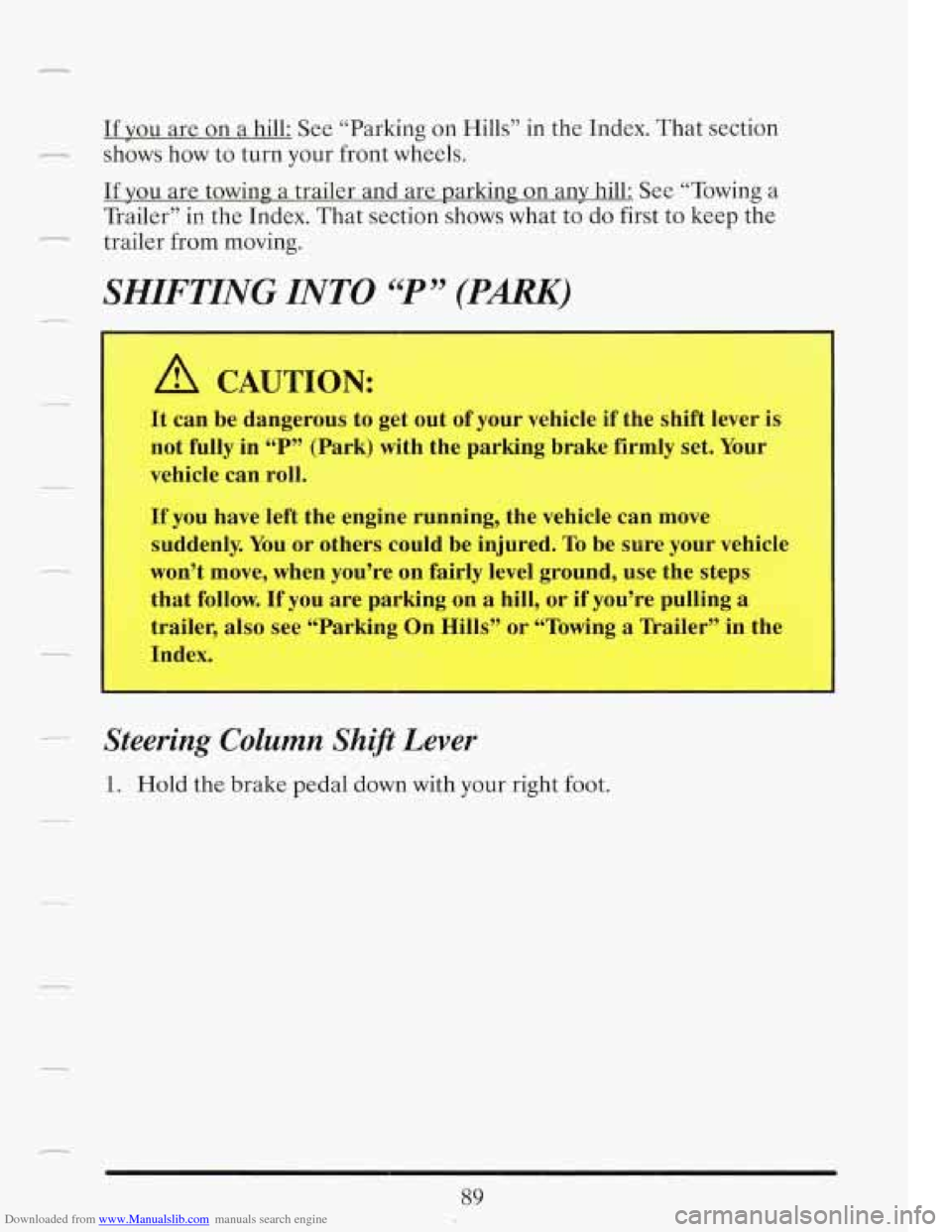
Downloaded from www.Manualslib.com manuals search engine If vou are on a hill: See “Parking on Hills” in the Index. That section
shows how to turn your front wheels.
If you are towing a trailer and are parking on any hill: See “Towing a
Trailer”
in the Index. That section shows what to do first to keep the
trailer from moving.
SHIFTING INTO “P” (PARK)
I A CAUTION:
It can be dangerous to get out of your vehicle if the shift lever is
not fully in
“P” (Park) with the parking brake firmly set. Your
vehicle can roll.
If you have left the engine running, the vehicle can move
suddenly. You or others could be injured. To be sure your vehicle
won’t move, when you’re on fairly level ground, use the steps
that follow.
If you are parking on a hill, or if you’re pulling a
trailer, also see “Parking On Hills” or “Towing a Trailer” in the
~ Index.
Steering Column Shift Lever
1. Hold the brake pedal down with your right foot.
89
Page 104 of 386
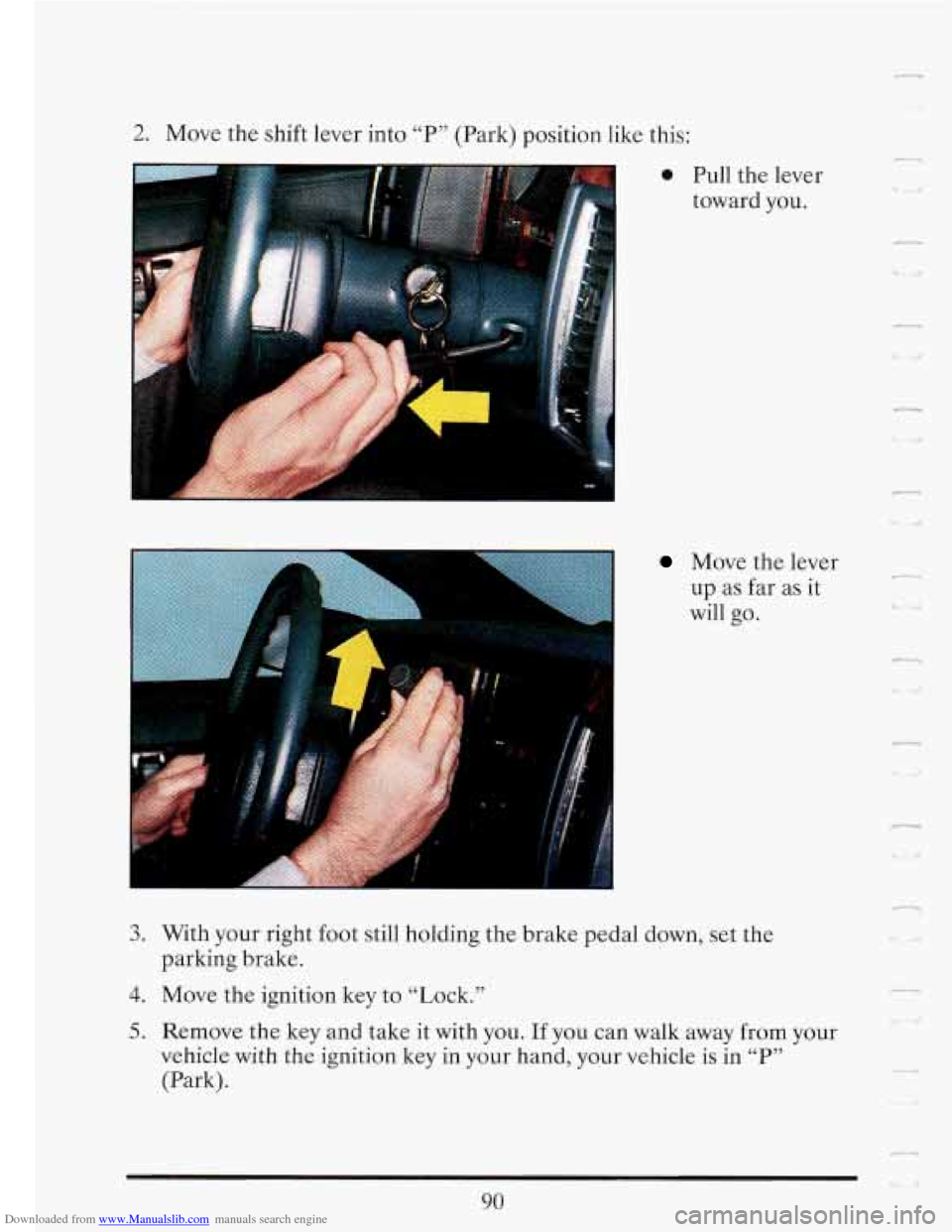
Downloaded from www.Manualslib.com manuals search engine 2. Move the shift lever into “P” (Park) position like this:
0 Pull the lever
toward you.
Move the lever
up as
far as it
will go.
n
W
3. With your right foot still holding the brake pedal down, set the
4. Move the ignition key to “Lock.”
parking brake.
5. Remove the key and take it with you, If you can walk away from your
vehicle
with the ignition key in your hand, your vehicle is in “P7’
(Park).
90